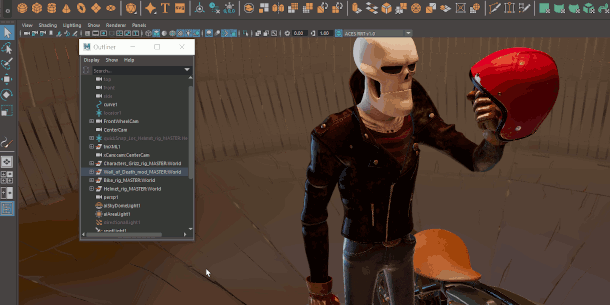Autodesk ships Maya 2020.2 and Maya LT 2020.2

Autodesk has posted lists of new features in Maya 2020.2 and Maya LT 2020.2 in the online documentation for the 3D modelling and animation software.
Changes common to both versions include workflow updates to the Outliner, a new Preserve UVs setting for Target Welds, and the option to run Viewport 2.0 in OpenGL mode on a remote desktop.
Outside the core application, the Maya to Arnold plugin now supports USD export and the option to render much larger scences generated by Maya’s Bifrost fluid simulation toolset.
Updated: Autodesk has tweeted to say that Maya 2020.2 is now available to download.
Maya 2020.2 and Maya LT 2020.2: updates to the Outliner
Compared to recent updates, the feature lists for both Maya 2020.2 and Maya LT 2020.2 are fairly short, and consist primarily of workflow improvements.
The main Outliner gets a new vertical splitter bar in addition to the existing horizontal splitter, helping to optimise use of interface space when working with complex scenes, as shown in the image above.
Users can also now create Sets and Quick Select Sets of scene objects from the Outliner contextual menu, as well as from the Create menu.
Maya 2020.2 and Maya LT 2020.2: new Preserve UVs option for Target Welds
Other changes include a new Preserve UVs option for the Target Weld tool, which enables users to choose whether the UVs of a model are modified by Target Welds, as shown above.
Users with Nvidia GPUs can also now run Viewport 2.0 in OpenGL mode when working on a remote desktop, instead of Maya automatically switching to DirectX 11 mode.
Maya 2020.2 only: reserve namespaces for file references
When working with referenced files, it is now possible to reserve a namespace for a reference even when the reference itself is not loaded, preventing it from being used inadvertently by other nodes.
Updates to the Maya to Arnold, Bifrost and Substance plugins
Outside the core application, Maya to Arnold (MtoA), the integration plugin for Autodesk’s Arnold renderer, gets the option to export Arnold scene data in USD format.
MtoA 4.0.3, released last month, also makes it possible to render scenes generated with Maya’s Bifrost simulation toolset containing geometry larger than 4GB.
The Bifrost for Maya plugin itself has also been updated, although 2.0.5.1 is a bugfix release.
According to the documentation, Adobe has also updated the Substance in Maya plugin, which makes it possible to edit materials in Substance Designer’s .sbsar format inside Maya.
At the time of writing, version 2.1.2 hasn’t been added to the online release notes, but it features “new scripting commands, an upgraded user interface [and] bug fixes”.
Pricing and availability
Maya 2020.2 is available for Windows 7/10, RHEL/CentOS 7.3-7.7 Linux and macOS 10.13+ on a rental-only basis. Since the previous release, the price of subscriptions has risen to $205/month or $1,620/year.
Maya LT 2020.2 is available for Windows 7/10 and macOS 10.13+ on a rental-only basis, with subscriptions now costing $35/month or $265/year.
Read a full list of new features in Maya 2020.2 in the online release notes
Read a full list of new features in Maya LT 2020.2 in the online release notes
